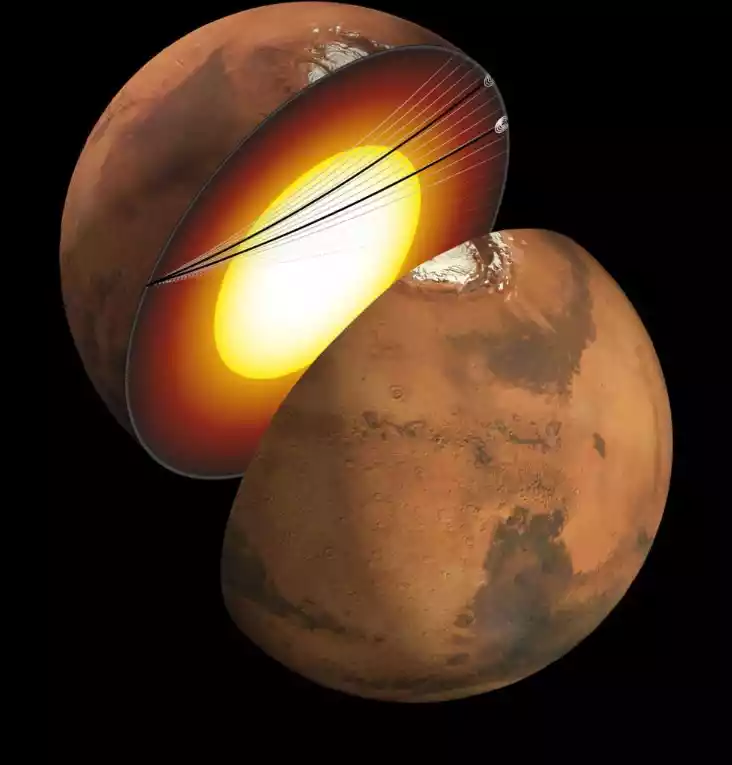Mars 1st Seismic Waves Confirm Liquid Core Existence
First Seismic Waves on Mars Confirm Liquid Core by measuring its first seismic waves caused by a meteor impact. The discovery sheds new light on the planet’s history.
Introduction
Mars 1st Seismic Waves Confirm Liquid Core Existence related to has always been a fascinating planet to study for scientists around the world, with its rocky terrain and similarities to Earth, scientists have always been curious about its geology and history. Recently, Mars has revealed new insights into its inner structure through the detection of its first seismic waves. The seismic waves confirmed the existence of a liquid core on the Red Planet, giving scientists new clues about how the planet formed and evolved over time.
Discovery of Mars’ Liquid Core

The discovery of Mars’ liquid core has been a significant breakthrough in planetary science. Scientists used data from the NASA InSight lander mission to measure seismic waves that were caused by a meteor impact over 4 billion years ago. The seismic waves were observed as they traveled through the planet, and scientists were able to determine that Mars has a completely liquid iron-alloy core with high percentages of sulfur and oxygen, unlike Earth’s core, which is a combination of a liquid outer core and a solid inner core.
Mars’ Liquid Core and Its Significance
The discovery of a liquid core on Mars is significant in many ways. It helps us understand the processes that shape rocky planets and may shed light on the formation and evolution of the solar system. The size of Mars’ liquid core suggests that the planet may have had a magnetic field in the past, which is similar to Earth’s magnetic field. The presence of a magnetic field is crucial for supporting life as it shields the planet from harmful solar winds.
Similarities and Differences Between Earth and Mars’ Cores
Mars’ liquid core makes the planet more similar to Earth than previously thought. The size and composition of the core are important factors in determining how planets form and evolve over time. The presence of a liquid core on Mars suggests that the planet may have had plate tectonics at some point in its history, which is another similarity to Earth. However, the chemical makeup of Mars’ core is different from Earth’s, with high percentages of sulfur and oxygen.
Importance of Studying Mars’ Liquid Core

Studying Mars’ liquid core could help us understand the processes that shape rocky planets and their evolution over time. It could also provide clues about the formation and evolution of the solar system. The discovery of a liquid core on Mars is significant in the search for potential extraterrestrial life as it helps us understand the conditions necessary for life to thrive. Further exploration and study of Mars’ core could lead to exciting new discoveries and insights about the planet.
Future Exploration of Mars’ Core
The measurement of seismic waves on Mars is a groundbreaking achievement in planetary science. Further exploration and study of Mars’ core could lead to new discoveries and insights about the planet. Future missions to Mars could focus on studying the planet’s core in more detail, including its magnetic field and composition. This could help us better understand the processes that shape rocky planets and the evolution of the solar system.
Challenges of Studying Mars’ Core
Studying Mars’ core is a complex and challenging task. The core is located deep within the planet, making it difficult to access and study. Seismic waves are the only way to measure the core’s properties, but they can be difficult to detect due to Mars’ thin atmosphere. Future missions to Mars will need to overcome these challenges to study the planet’s core in more detail.
Conclusion
The discovery of Mars 1st Seismic Waves Confirm Liquid Core Existence liquid core through the measurement of its first seismic waves is a significant breakthrough in planetary science. It provides new insights into the planet’s geology and history and helps us understand the processes that.
Also read this post for more updates: Bed Bath & Beyond filed for bankruptcy
How AI Accidents Could Skyrocket in 2023
FAQ
Q: What are the first seismic waves on Mars?
A: The first seismic waves on Mars were detected by the NASA InSight lander mission and confirmed the existence of a liquid core on the planet.
Q: Why is the discovery of a liquid core on Mars significant?
A: The discovery of a liquid core on Mars provides new insights into the planet’s geology and history, and makes Mars more similar to Earth than previously thought.
Q: What is the size of Mars’ liquid core?
A: The size of Mars’ liquid core is estimated to be approximately 1,830 miles (2,950 kilometers) in diameter.
Q: What does the presence of a liquid core on Mars suggest about the planet’s past?
A: The presence of a liquid core on Mars suggests that the planet may have had a magnetic field in the past.
Q: How does studying Mars’ liquid core help us understand other planets?
A: Studying Mars’ liquid core may help us understand the processes that shape rocky planets, and shed light on the formation and evolution of the solar system.
Q: Is there potential for extraterrestrial life on Mars?
A: The discovery of a liquid core on Mars is significant in the search for potential extraterrestrial life, as it provides new information about the planet’s geology and history.
Q: What is the significance of measuring seismic waves on Mars?
A: Measuring seismic waves on Mars is a groundbreaking achievement in planetary science, and can provide valuable information about the planet’s interior and formation.
Q: What are the potential future implications of further exploration and study of Mars’ core?
A: Further exploration and study of Mars’ core could lead to exciting new discoveries and insights about the planet, and provide valuable information for future missions to Mars
